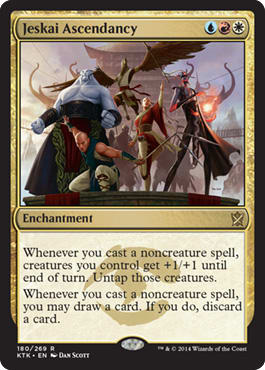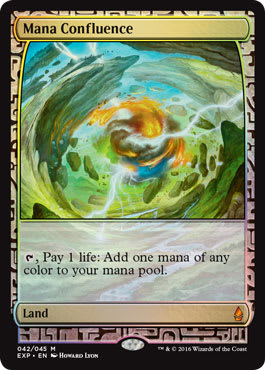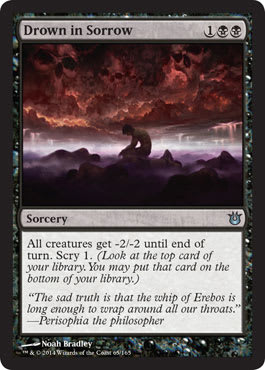Last week, we started seeing a little more conformity to what was being played at the larger events; this is typical of a format after a month or so in. The truly interesting part is when something so innovative and unique springs up this far into a format that it makes people scratch their heads and wonder how they missed it. That is precisely what happened this week at the StarCityGames Open Standard portion, and this combo player could not be happier.
If you have not seen the decklist yet, go ahead and take a quick look. What do you notice after looking over the list?
Heroic Jeskai Combo ? Khans of Tarkir Standard | Ivan Jen, 1st Place in StarCityGames Oakland Standard Open
- Creatures (16)
- 2 Lagonna-Band Trailblazer
- 2 Seeker of the Way
- 4 Akroan Crusader
- 4 Favored Hoplite
- 4 Monastery Swiftspear
- Spells (26)
- 2 Jeskai Charm
- 4 Defiant Strike
- 4 Gods Willing
- 4 Retraction Helix
- 4 Dragon Mantle
- 4 Jeskai Ascendancy
- 4 Springleaf Drum
- Lands (18)
- 1 Temple of Enlightenment
- 2 Shivan Reef
- 3 Mana Confluence
- 4 Battlefield Forge
- 4 Mystic Monastery
- 4 Temple of Triumph
- Sideboard (15)
- 3 Chasm Skulker
- 2 Seeker of the Way
- 2 Ajani's Presence
- 1 Disdainful Stroke
- 3 Erase
- 2 Magma Jet
- 2 Negate
As I am sure you noticed, this deck could be built in a cave from a box of scraps. Seriously, though, you probably have most of this in your Draft leftovers, and beyond the mana base, this deck costs even less than an Event Deck. If you want a cheap, reliable deck that will certainly be a blast to play, I suggest picking this up now.
The key to this type of deck for anyone new to combo is gold-fishing. The convenient part about this is that you do not need anyone else to learn the interactions of your deck. Though this will not always leave you completely prepared for what your opponent can do to disrupt you, it will give you a stronger idea of what lines of play work and what cards you need in order to play through each situation. Maybe you kept a hand that looked playable, only to do nothing for five turns. These types of things are much easier to see when gold-fishing, as you concentrate solely on your play and not on what an opponent may have or how he or she is playing. I have seen many pilots new to combo pick up decks over the years and miss lines of play that only come with such testing; if you plan to play this deck, start now.
I put this together on Magic Online the day it came out, and though I said I would test the old build through the beginning of the week, I was willing to switch given how much more powerful this variant is. Last week, I talked about how I wanted to form a transformational sideboard to combat some of the hate for the combo. Well, it seems Ivan Jen did all of the work for me and found not only an alternate win condition, but also a way to fit it in the main deck while leaving the combo intact.
We have seen combo decks before; we have seen combo control such as Psychatog dominate formats in the past given the versatility. Midrange combo, such as Melira Pod, has also dominated within its respective format now for a few years. The reason these decks usually make such impact is that they have a frame for which they can play a fair game of Magic, many times enough to win on its own. This means attacking the combo out of the board suddenly leaves you with less than desirable cards if the deck plays the fair game. It can be hard to board against these decks since the angle of attack can change from game to game, and after boarding, it is possible one line comes out completely, leaving you with potentially dead cards if you misjudged the situation.
For me, what makes this deck extra exciting is that it is one of the rare times in Magic history when we see a combo deck that pairs with a very aggressive aggro shell. Elves is another example of a deck that can pull out fair wins using the cards that would normally combo as a supplement in some games to allow you to just overwhelm your opponent with creatures. These shells are particularly scary if the format is not ready because, many times, the hate cards people bring in are clunky or slow—or else deal damage or force a tempo loss, such as Thoughtseize, or force a turn-two Bile Blight instead of allowing the opponent to play a Sylvan Caryatid.
The ability to kill your opponent before turn five consistently—and from multiple angles—certainly has its merits, but it is not the end of the world. This deck is very beatable; yes, it was probably the best deck in Oakland for the existing metagame, but what this deck did is push the format forward from this midrange-dominated beginning we have seen. I am not only excited for this deck, which is a blast to play, but also for the future evolution of the format now knowing something this powerful and resilient exists.
So outside of this deck being exactly what I was looking for in the format, it does have one small financial implication. Mana Confluence is a card I have not talked about in a few months, and I feel it once again needs some attention. Though fewer decks started with the card than I anticipated, it has become increasingly clear that it is in fact played across archetypes and is growing slowly in popularity. This Jeskai deck is just one I have seen—among all of the Daily Event and other large-event finishes—that is trying to push its enters-the-battlefield-untapped mana to support two or more colors in the first few turns.
Mana Confluence has gone up some since rotation, but one thing that is not represented in the retail number alone is how close the spread between buy-list prices, TCGplayer low prices, and TCGplayer mid prices has been at times since then. Magic Online has also seen some significant growth on the card in the past few months, and even more so in recent weeks. As I have begun to study the market, I have noticed a trend among rares; it seems that any time a rare on Magic Online can grow beyond the paper price, we are poised for a jump shortly after if the spike is not artificial. There are arguments for saying this Jeskai Combo deck has impacted this price recently due to how cheap it is to build otherwise, but you can usually see a market drop-off just as quickly if the idea is a flash in the pan. The Magic Online market moves much faster than paper and can jump and fall before the market even has time to adjust outside of the digital world—that has not been the case here. I called Mana Confluence as a bold potential to hit $30 during its life in Standard, and I can see that happening before the next set if this trend continues.
It doesn’t seem very fair to leave this week so heavily weighted solely on Jeskai Ascendancy, but for now, until we see more results, it is difficult to know how most decks will adapt to have a better matchup, so posting any other list this week just seems obsolete by time you read this. That being said, let us instead look at some of the more general cards that may play well into the coming metagame if in fact it does shift in any capacity and what that can mean for their future. This week, I am mostly going to stick to the smaller cards that have higher upside since making predictions on the already inflated cards is much riskier without seeing some new lists.
Before identifying the answers to the format, we must really figure out what exactly can be done to combat this deck while still leaving your lists capable of winning in a timely fashion. Drown in Sorrow is one card that has been seeing more and more play since rotation, and it does not appear that is going to change. Picking up copies of Drown in Sorrow now while you can still find them seems like a safe, small investment for a few months down the road. Undeniably, aggro is a factor in this format, and Drown in Sorrow is a good catchall against a number of decks right now.
I touched on Spirit of the Labyrinth this week on Brainstorm Brewery, and since I know many of you listen as well as read, I don’t want to spend much time on the card. It really seems to fit the bill as a good 2-drop that can get in early damage as well as prevent card-draw from a number of decks. Spirit is not a direct answer to any one deck, but it seems the ability is becoming more relevant—this combo deck certainly has fits against the card the few times I have seen it. Forcing your opponent to remove your 2-drop before trying to gain any card advantage can be a huge boon in a deck that can already play spells in a more rapid succession than the current one-play-a-turn metagame that Abzan has brought us.
The last card I want to touch on this week is less of something to pick up, as the price is already very high, but something to watch for and maybe hold or trade for when you can. Brimaz, King of Oreskos has been climbing back into many lists as a good answer to some of these more aggressive decks. As the format becomes faster, it seems Goblin Rabblemaster has fallen slightly out of favor in many lists, being replaced by Brimaz. His price is slowly trending upward now, but I could see it continuing given the scarcity for which I see these in binders.
Next week, I will go a little more into my testing results from Magic Online and see what changes I want to make to the heroic combo deck. I expect a few changes to the main deck and probably a revamp of the board for the Magic Online metagame, but I am really happy to have this list as a starting point. I hope we see some shakeup this weekend as people bring their answers to the table. Combo is typically not the end-all of any format—there are answers, and the meta will shift. Check back next week to see where it goes!

























